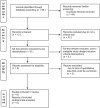Therapeutic Effects of Umbilical Cord Serum for Dry Eye Disease: A Systemic Review and Meta-Analysis
- PMID: 39622221
- PMCID: PMC11844691
- DOI: 10.1159/000542731
Therapeutic Effects of Umbilical Cord Serum for Dry Eye Disease: A Systemic Review and Meta-Analysis
Abstract
Introduction: Dry eye disease (DED) is a prevalent ocular condition that significantly impacts quality of life. Umbilical cord serum (UCS) has emerged as a promising therapeutic option, but its efficacy requires further investigation. This systemic review and meta-analysis aimed to evaluate the therapeutic effects of UCS eye drops in the treatment of DED.
Methods: A comprehensive literature search was conducted across multiple databases, including PubMed, Web of science, Embase, Science Direct, Cochrane Library, and China National Knowledge Network, to identify relevant clinical trials. The efficacy of UCS was assessed based on key outcome measures, such as the ocular surface disease index (OSDI), tear break-up time (TBUT), Schirmer I test, and corneal fluorescein staining scores. Meta-analyses were performed to pool the results, and the findings were presented in a forest plot.
Results: Eight studies were included in the meta-analysis, with two relevant randomized controlled trials (RCTs) involving a total of 204 patients. Most of the included studies had a follow-up time of less than 2 months. The pooled results showed that UCS treatment significantly improved the OSDI, with a mean difference (MD) of -9.16 (95% confidence interval [CI], -12.0, -6.36) compared to baseline. Additionally, the TBUT values were higher in the UCS group, with an MD of 2.65 (95% CI, 0.93, 4.36). The Schirmer I test results showed an improvement, with an MD of 1.18 (95% CI, 0.30, 2.06). The fluorescein staining score were also lower in the UCS treatment group, with an MD of -4.71 (95% CI, -5.72, -3.69).
Conclusion: This meta-analysis suggested that UCS eye drops had a beneficial therapeutic effect on DED, significantly improving the OSDI, TBUT, Schirmer I test, and corneal fluorescein staining scores. However, larger RCTs with longer follow-up periods were needed to further evaluate the long-term efficacy and safety of UCS in the management of DED.
Keywords: Dry eye disease; Meta-analysis; Umbilical cord serum.
© 2024 The Author(s). Published by S. Karger AG, Basel.
Conflict of interest statement
The authors have no conflicts of interest to declare.
Figures









References
-
- Craig JP, Nichols KK, Akpek EK, Caffery B, Dua HS, Joo CK, et al. . TFOS DEWS II definition and classification report. Ocul Surf. 2017;15(3):276–83. - PubMed
-
- Módis L, Szalai E. Dry eye diagnosis and management. Expert Rev Ophthalmol. 2011;6(1):67–79.
-
- Schaumberg DA, Sullivan DA, Buring JE, Dana MR. Prevalence of dry eye syndrome among US women. Am J Ophthalmol. 2003;136(2):318–26. - PubMed
-
- Stern ME, Gao J, Siemasko KF, Beuerman RW, Pflugfelder SC. The role of the lacrimal functional unit in the pathophysiology of dry eye. Exp Eye Res. 2004;78(3):409–16. - PubMed
Publication types
MeSH terms
Substances
LinkOut - more resources
Full Text Sources

